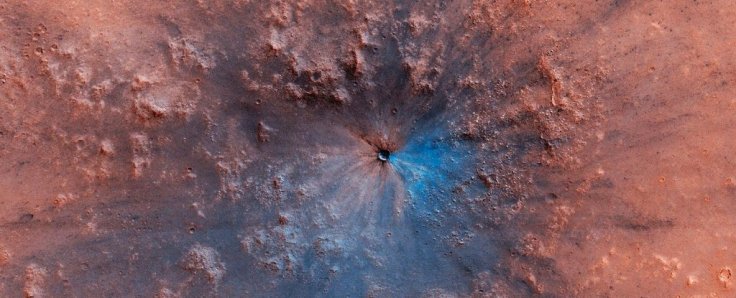
A fresh impact crater, spotted by the Mars Reconnaissance Orbiter (MRO), was never seen before by astronomers as its size and impact waves in black and blue make it stand out on the surface of the red planet like a sore thumb.
Astronomers believe that the crater was created sometime between September 2016 and February 2019 by one of 200 and odd asteroids and comets which bombard the planet each year.
The dramatic, enhanced-colour scene of the crater was captured using NASA's High Resolution Imaging Science Experiment (HiRISE) camera, orbiting 255 kilometres away (158 miles). Unlike other craters with dark smudges, this crater is the most impressive one, said University of Arizona planetary scientist Veronica Bray.
In its 13 years of orbiting the Mars, the MRO satellite has rarely captured such an impact on Mars, which is constantly bruised by foreign bodies and storms. The asteroid or comet that caused the crater could be about 1.5 metres wide while the impact it created measures anywhere between 15 to 16 metres wide.
Unlike the earth's much thicker atmosphere, even such a tiny rock was able to reach the surface of the red planet, that too in one shape, said experts, indicating that it must have been more solid than usual.
In this case, the spot was in the Valles Marineris region, near the Martian equator. "What makes this stand out is the darker material exposed beneath the reddish dust," said the HiRISE on its website.
The dark zone in the middle of the image, shows that the dust has been pushed aside revealing the unusual depth it has created beneath the surface. Bray said that the surface below could be basalt and the blue color in the image could be ice that was uprooted due to the impact.
2009 Crater
Last time in 2009, a crater measuring 12-meter-wide was found on Mars in mid-latitude northern region which could have been created by an impact that occurred repeatedly between July 3, 2004, and June 28, 2008. The image taken by the High Resolution Imaging Science Experiment camera on NASA's Mars Reconnaissance Orbiter on Jan. 8, 2009, shows the difference below:

The impact resulted in excavated water ice from below the surface of Mars as seen in the form of the bright material visible in this pair of images. This 2009 crater is at 46.16 degrees north latitude, 188.51 degrees east longitude on Mars.









